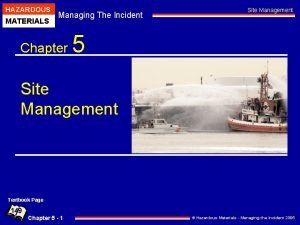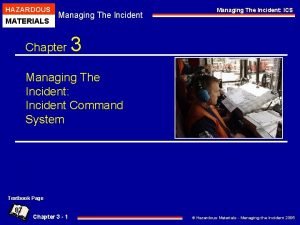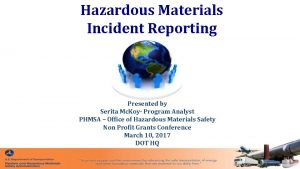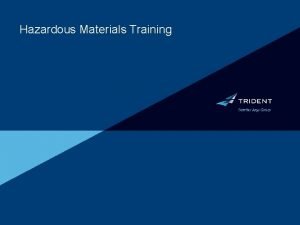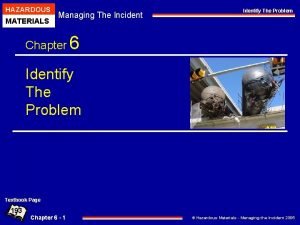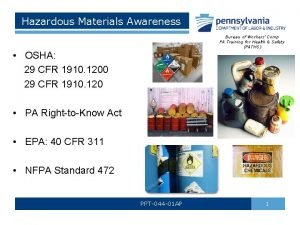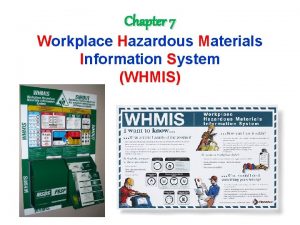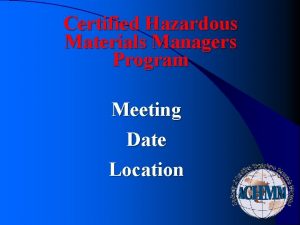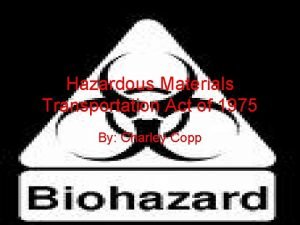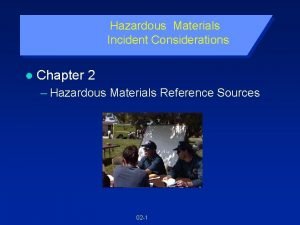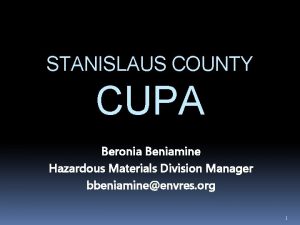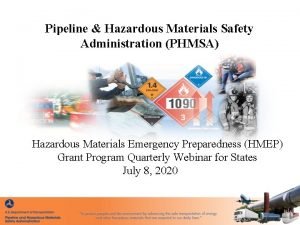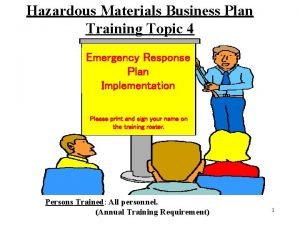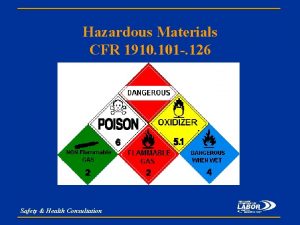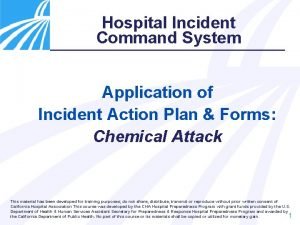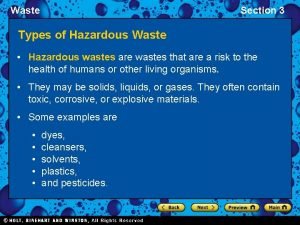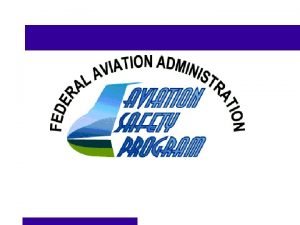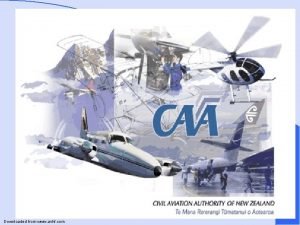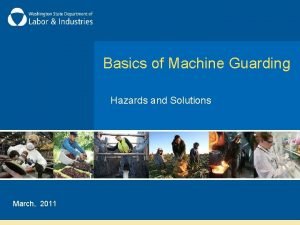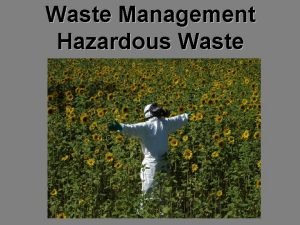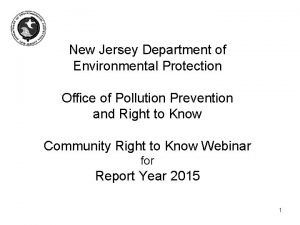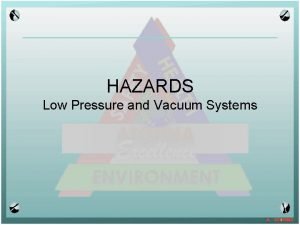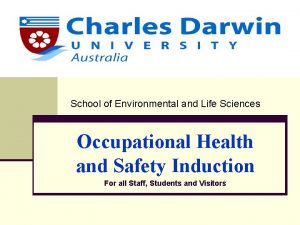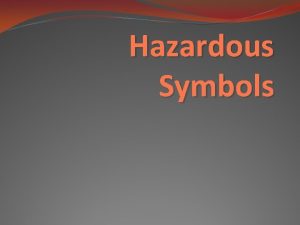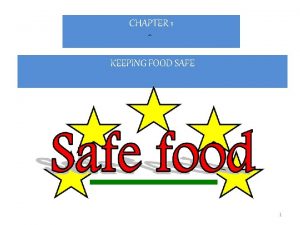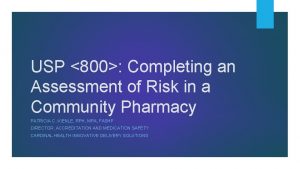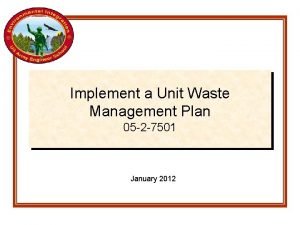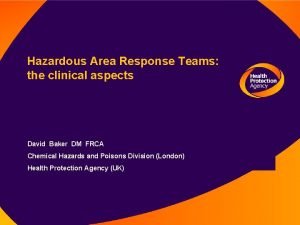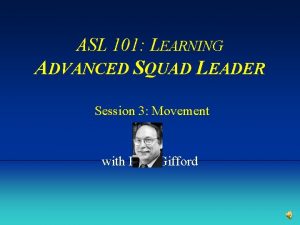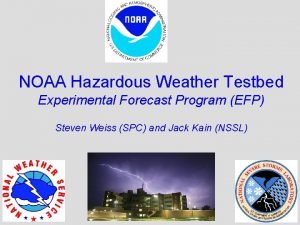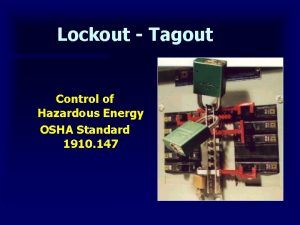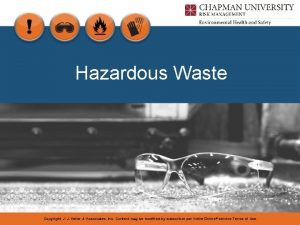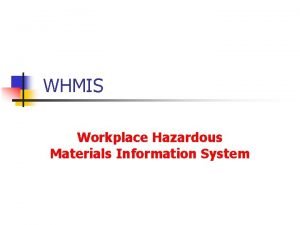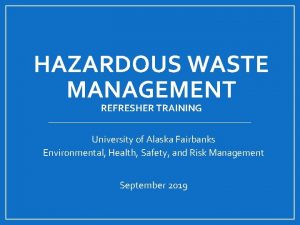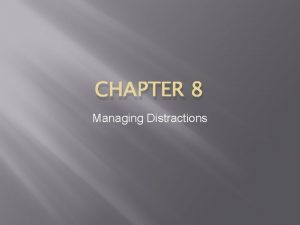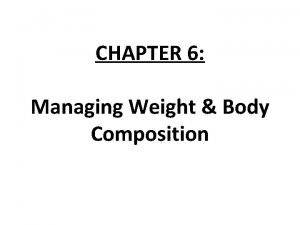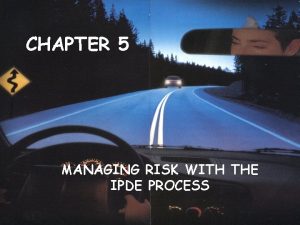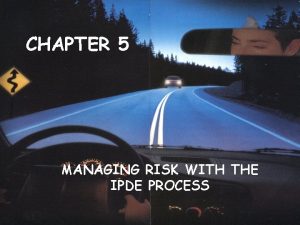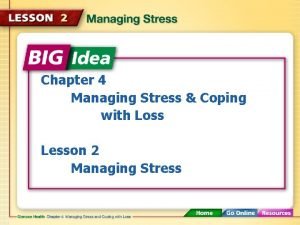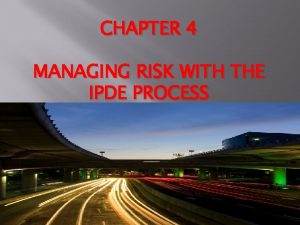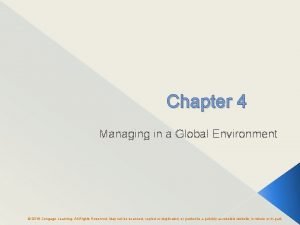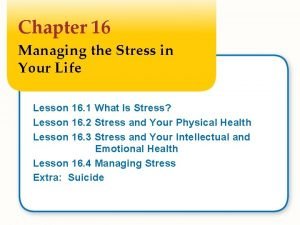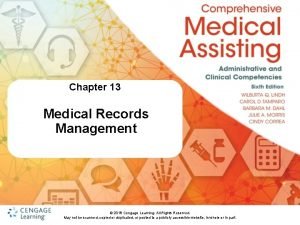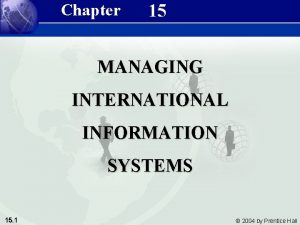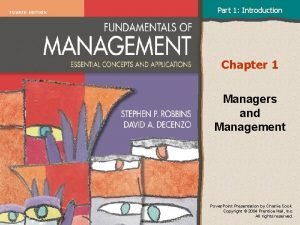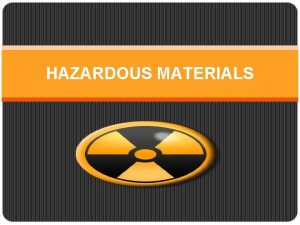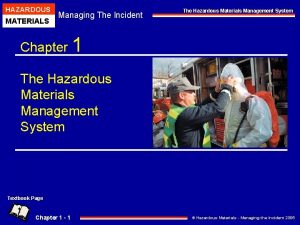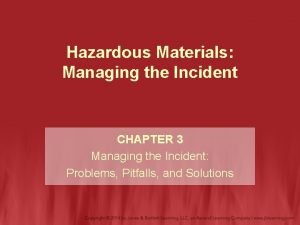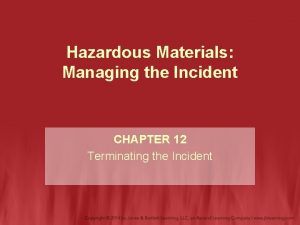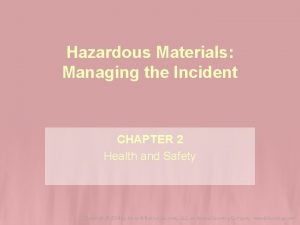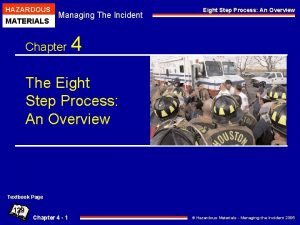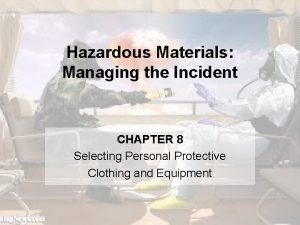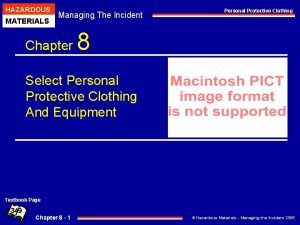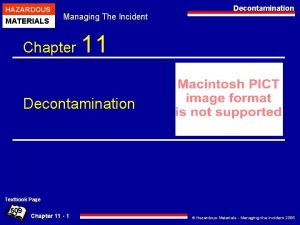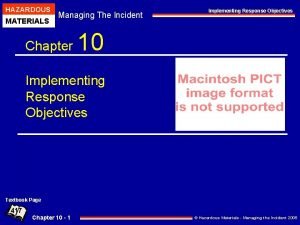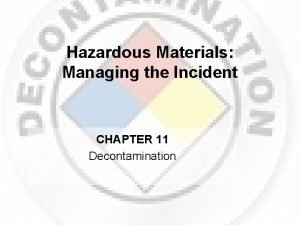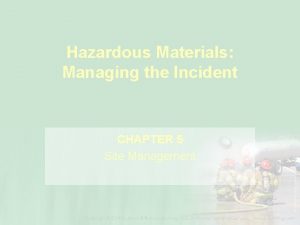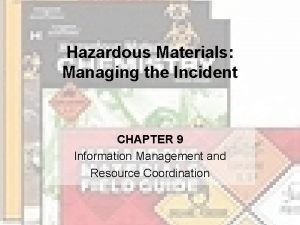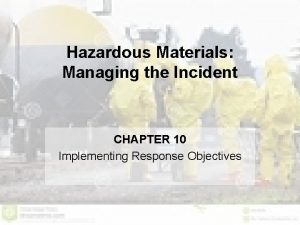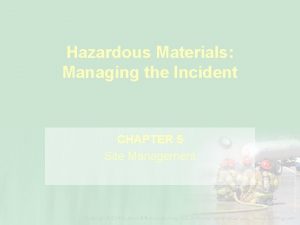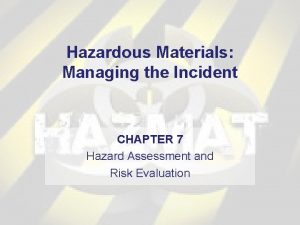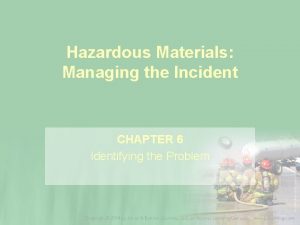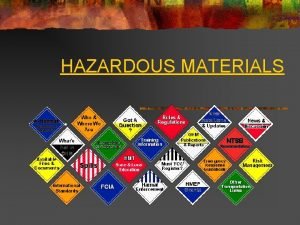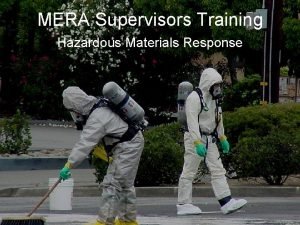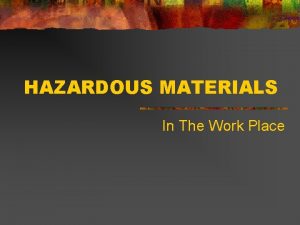Hazardous Materials Managing the Incident CHAPTER 1 The

































































- Slides: 65

Hazardous Materials: Managing the Incident CHAPTER 1 The Hazardous Materials Management System

Role of the Hazardous Materials Technician • Respond – Significantly different than Awareness/Operations response – Typically more aggressive, proactive control measures • Analyze – Plan a risk based response • Select applicable decontamination procedures • Control – The release – Control equipment / container

Role of the Hazardous Materials Technician • Scene safety • Manage the Scene – Meet the requirements of 1910. 120 (q) • Knowledge • Skills • Manage/stabilize WMD, terrorist, or criminal scenarios – Operate as a member • HSRT/HMRT • Unified response

What is a Hazardous Material? (1 of 3)

What is a Hazardous Material? (2 of 3) • Hazardous materials can be found almost anywhere. – – Industry Transportation Workplace Home • Hazardous materials can also be used as a weapon for criminal or terrorist purposes.

What is a Hazardous Material? (3 of 3) • Ludwig Benner, Jr. – Former specialist (NTSB) – Defined hazardous materials: – Any substance that jumps out of its container when something goes wrong and hurts or harms the things it touches – Emergency response is both: • Container issue • Chemical issue Courtesy of Don Sellers

Hazmat Laws, Regulations, and Standards • Hazmat operations involving the manufacture, transport, use, and incident response are affected by: – Laws • Federal • State – Regulations – Consensus standards

Hazmat Laws, Regulations, and Standards • Federal hazmat laws – Enacted by Congress to regulate everything from finished products to hazardous waste – RCRA • Resource Conservation & Recovery Act (1976) • Established framework for management & disposal – CERCLA • Comprehensive Environmental Response, Compensation, and Liability Act (1980) – Aka: Superfund • Addresses releases and cleanup of waste disposal sites

Hazmat Laws, Regulations, and Standards • SARA – Superfund Amendments and Reauthorization Act (1986) – Amended and reauthorized Superfund – Established a baseline for: • Planning, Right to Know, Preparedness • Training & Response – SARA Title I • Development of – OSHA 1910. 120 – HAZWOPER – SARA Title III • Establishment of SERC’s & LEPC’s

Hazmat Laws, Regulations, and Standards • OPA – Oil Pollution Act (1990) – Required development of ERP’s – Regular training & exercises • CAA – Clean Air Act (1990) – Establishment of National Chemical Safety & Hazard Investigation Board

Hazmat Laws, Regulations, and Standards • Hazmat regulations – Laws delegate certain details of implementation and enforcement to federal, state, or local agencies. • These agencies are then responsible for writing the actual regulations. – Regulations will either: • Define the broad performance required to meet the letter of the law • Provide very specific and detailed guidance on satisfying the regulation

Hazmat Laws, Regulations, and Standards • Federal regulations – Code of Federal Regulations (CFR) • Publication containing all the rules and regulations enforced by the various federal departments and agencies. – Hazardous Waste Operations and Emergency Response • Establishes requirements for both industry and public safety organizations that respond to hazmat or hazardous waste emergencies – Written & enforced by OSHA (1910. 120) – “Non-OSHA” states • EPA (40 CFR 311)

Hazmat Laws, Regulations, and Standards • HAZWOPER requirements cover: – Haz. Mat ERP’s – Use of IMS – Buddy systems & backup personnel – Establishment of a Safety Officer – Specific training covering: • Instructors • Initial training – Refresher training – Medical surveillance program – Post-emergency termination procedures

Hazmat Laws, Regulations, and Standards • SERC – State planning groups are referred to as SERCs – SERC is responsible for: • Developing and maintaining the state’s emergency response plan • Ensuring that planning and training are taking place throughout the state • Providing assistance to local governments, as appropriate

Hazmat Laws, Regulations, and Standards • LEPC – Coordinating point for both planning and training activities at the local level – LEPC membership are representatives from the following groups: • • • Elected state and local officials Fire Department Law Enforcement Emergency Management Public health officials Hospital

Hazmat Laws, Regulations, and Standards • Hazard Communication (HAZCOM) Regulation (29 CFR 1910. 1200) – Requires hazardous materials manufacturers and handlers to develop written material safety data sheets (SDS) • Examples of information on SDSs: – Known health hazards – Physical and chemical properties of the material – First aid, firefighting, and spill control recommendations – Protective clothing and equipment requirements – Emergency telephone contact numbers

Hazmat Laws, Regulations, and Standards • Hazardous materials transportation regulations (49 CFR 100– 199) – Issued and enforced by the U. S. DOT • Hazardous materials transportation regulations govern: – Container design – Chemical compatibility – Packaging and labeling requirements – Shipping papers – Transportation routes and restrictions

Hazmat Laws, Regulations, and Standards • Pipeline regulations (49 CFR Part 190− 199) – Issued by the DOT Pipeline and Hazardous Materials Safety Administration (PHMSA) • Establishes rules and regulations governing design, construction, operation, safety, and maintenance of interstate pipelines – Regulate oil, gas, liquefied natural gas (LNG), and other hazardous liquid pipelines and facilities – Part 194 • Outlines emergency planning for onshore pipeline incidents

Hazmat Laws, Regulations, and Standards • National Contingency Plan (NCP; 40 CFR 300, Subchapters A through J) – Outlines the policies and procedures of the National Oil and Hazardous Materials Response Team (also known as the National Response Team, or the NRT) • The NRT is chaired by the EPA. • Each of the 10 federal regions also has a Regional Response Team (RRT) • When activated for a federal response, a Federal On-Scene Coordinator (FOSC) will be designated to coordinate the overall response.

Hazmat Laws, Regulations, and Standards • National Contingency Plan (NCP; 40 CFR 300, Subchapters A through J) (cont’d) – Terrorism-related event • Federal Bureau of Investigation(FBI) will assume the role as federal OSC during the emergency response phase. – Facility and modal security regulations were enacted in the aftermath of the terrorist attacks of September 11, 2001.

Hazmat Laws, Regulations, and Standards • State and local regulations – Each of the states and the U. S. territories maintains an enforcement agency that has responsibility for hazardous materials. – Three key players in each state: • State fire marshal • State Occupational Safety and Health Administration • State Department of the Environment

Voluntary Consensus Standards • Provides a way for individual organizations and corporations to self-regulate their businesses – The National Fire Protection Agency (NFPA) – The American Society of Testing and Materials (ASTM) – The National Institute of Justice (NIJ)

Voluntary Consensus Standards • NFPA 472 – Specify minimum competencies for those who respond to hazardous materials/WMD incidents – Overall objective • Reduce the number of accidents and prevent exposure to hazmats – Includes levels of training • Developed to meet specific hazardous materials training and response needs

Voluntary Consensus Standards • OSHA 1910. 120 and NFPA 472 – Differences • OSHA 1910. 120 is the LAW - NFPA 472 is VOLUNTARY • NFPA 472 exceeds the OSHA HAZWOPER emergency response training requirements (Paragraph q. 6) • OSHA 1910. 120 has not been revised since 1989 – NFPA 472 (2013 edition) is in its fifth edition of the standard

Voluntary Consensus Standards • NFPA 473 – Specify minimum requirements of competence and to enhance the safety and protection of response personnel and all components of the EMS system – Overall objective • Reduce the number of EMS personnel accidents, exposures, injuries, and illnesses resulting from hazmat incidents

NFPA 475: Recommended Practice for the Organization and Management of a Hazardous Materials/Weapons of Mass Destruction Emergency Response Program • Scope of this recommended practice • Establish a common set of criteria for the organization & management • Deployment of personnel & resources • Programs for those public or private entities that are responsible for the hazardous materials/WMD emergency preparedness function.

NFPA 1072: Standard on Hazardous Materials Response Personnel Professional Qualifications • This document is currently under development with an anticipated NFPA publication date of 2016. • This will be a hazardous materials Pro. Qual standard that is job performance requirements (JPR)-based for the following response levels: a)Awareness b)Operations core c)Operations mission specific d)HMT e)Incident commander

Voluntary Consensus Standards • The NFPA Technical Committee on Hazardous Materials Protective Clothing and Equipment (NFPA 1991, 1992, 1994) – Responsible for the development of standards and documents pertaining to the use of personal protective clothing and equipment • (excluding respiratory protection)

Voluntary Consensus Standards • The NFPA Technical Committee on Hazardous Materials Protective Clothing and Equipment (NFPA 1991, 1992, 1994) (cont’d) – Committee scope includes personal protective equipment (PPE) selection, care, and maintenance. – Three hazmat protective clothing standards (NFPA 1991, 1992, and 1994)

Voluntary Consensus Standards • Other standards organizations – The American National Standards Institute (ANSI) – The American Society for Testing and Materials (ASTM) – The Compressed Gas Association (CGA) – The Safety Equipment Institute (SEI) – The American Petroleum Institute (API)

Standard of Care • The standard of care represents the minimum accepted level of service. • The standard of care is established by: – Existing laws and regulations – Voluntary consensus standards and recommended practices – Local protocols and practices

Standard of Care • Meeting the Standard? – Consider the following: • Our actions and decisions must be consistent with voluntary consensus standards and recommended practices. • Our operations must be legal and within the requirements of the law • Our actions and decisions to control a problem should have a technical foundation. • Our actions and decisions must be ethical.

The Hazardous Materials Management System • Elements of a hazardous materials management systems approach: – – Planning and preparedness Prevention Response Clean-up and recovery

The Hazardous Materials Management System • Planning and preparedness – First and most critical element of the system. » Fundamentally a process to manage risk. – Risk management is a process by where risks are identified and assessed – The ability to develop and implement an effective hazmat management plan depends upon two elements: » Hazards analysis » Development of a hazmat emergency operations plan

Hazards Analysis • Hazards analysis is the foundation of the planning process. • There are four components of a hazards analysis program: – – Hazards identification Vulnerability analysis Risk analysis Emergency response resource evaluation

Hazards Analysis • Hazards identification is initially based on a review of the history of incidents. Information should include: – – – – Chemical identification Location of facilities Type(s) and design(s) of chemical container Quantity of material Nature of the hazard associated with the hazmat release Presence of any fixed suppression Level of physical security

Hazards Analysis • Vulnerability analysis: – – – The size/extent of vulnerable zones Equipment The population Private and public property that may be damaged Environment that may be affected • Risk analysis: – The probability or likelihood of an accidental release – The actual consequences that might occur

Hazards Analysis • Emergency response resources are evaluated based upon the potential risks and considers resource requirements including: – – – Personnel Equipment Supplies for hazmat control and mitigation EMS Protective actions Traffic control

Contingency and Emergency Operations Planning (1 of 2) • Emergency management planning process includes: – Collaborative planning team – Understanding the situation – Determining goals and objectives

Contingency and Emergency Operations Planning (2 of 2) • Emergency management planning process includes: (cont’d) – Plan development – Plan preparation, review, and approval – Plan implementation and maintenance

Other Planning Documents • Documents that support the emergency preparedness process include: – Pre-incident plans – Standard operating procedures/guidelines (SOP/SOG) – Field operations guides (FOG) • Short form version of SOP/SOG – Job aids are checklists or other materials that help users perform a specific task.

CAER and TRANSCAER • Public and private sector planning programs include: – Community awareness and emergency response (CAER) programs – Transportation community awareness and emergency response (TRANSCAER) programs

Hazmat Process, Container Design, and Construction Standards • Almost all hazardous materials facilities, containers, and processes are designed and constructed to some standard. – Engineering standards and guidelines – Voluntary consensus standards including: • NFPA • ASTM • Government regulations

Inspection and Enforcement (1 of 2) • Fixed facilities are inspected by: – State and federal OSHA and EPA inspectors – State fire marshals and local fire departments • Inspections focused on fire and life safety issues • May not adequately address either the environmental or process safety issues

Inspection and Enforcement (2 of 2) • Transportation vehicle inspection is generally based upon Title 49 CFR. • Enforcing agencies include: – State police – U. S. DOT agencies • Federal Railroad Administration (FRA) • Federal Aviation Administration (FAA) • U. S. Coast Guard (USCG)

Public Education (1 of 2) • Hazmat safety is a concern for the community. • Improper disposal of substances used in the home contributes to this problem. – – Used motor oil Paints, solvents Batteries Other chemicals

Public Education (2 of 2) • Pipeline operators must provide regular training to emergency responders. • Pipeline operators have extensive public education programs pertaining to the use of the One Call System and the Dig Safely program.

Handling, Notification, and Reporting Requirements • Key federal regulations: – CERCLA (Superfund) – RCRA – SARA Title III • Many state regulations are similar in scope or often exceed the federal standard requirements.

Response • Activities and operational capabilities should be based on information and probabilities identified during the planning process. • Every community should have access to a technician-level hazmat response capability.

Response Groups • The emergency response community consists of various agencies and individual hazmat responders categorized based upon their: – Knowledge – Expertise – Resources

Levels of Incident • The National Incident Management System (NIMS) categorizes incidents into five types. • Based on the scope, impact, and resource requirements of the incident – Type 1 incident is the most significant. – Type 5 incidents are the smallest, most common.

Hazmat Response Team (HMRT) (1 of 4) • NFPA 472 – Organized group of trained response personnel operating under an emergency response plan and standard operating procedures who perform HMTlevel skills • The purpose of the HMRT is to control or stabilize the incident.

Hazmat Response Team (HMRT) (2 of 4) • In evaluating the need for an HMRT, consider that an HMRT will not necessarily solve the hazmat problem. • Remember the hazardous materials management system—planning, prevention, response, and recovery.

Hazmat Response Team (HMRT) (3 of 4) • HMRT constraints and requirements: – – – – Legal Insurance Political issues Initial and continuing funding sources Resource determination and acquisition Personnel and staffing Initial and continuing training

Hazmat Response Team (HMRT) (4 of 4) • HMRTs typically function as a group or branch within the Incident Command System. • The final decision always remains with the incident commander.

Clean-Up and Recovery (1 of 4) • Clean-up and recovery operations are designed to: – Clean up or remove the hazmat release – Restore the facility and/or community back to normal as soon as possible • Clean-up activities can be classified as follows: – Short term – Long term

Clean-Up and Recovery (2 of 4) • Any substance designated under the Clean Water Act and the Comprehensive Environmental Response, Compensation, and Liability Act as posing a threat to waterway • Recovery operations focus on restoring the facility, the community, and/or emergency response organization to normal operating conditions.

Clean-Up and Recovery (3 of 4) • Recovery operation tasks include: – Restocking all supplies and equipment – Compilation and documentation of resources purchased and/or used – Financial restitution, where appropriate • Post-incident issues: – Identifying a responsible party (RP) – Recovering allowable costs associated with the incident response

Clean-Up and Recovery (4 of 4) • Hazmat incident cost recovery options may include: – Establishment of a local cost recovery ordinance/legislation and supporting fee structures – Voluntary efforts through the RP’s insurance carrier – EPA Local Government Reimbursement (LGR) Program

Role of Emergency Responders During Clean-Up Operations (1 of 4) • Many plant-level industrial responders are responsible for the clean-up of minor spills and releases. • Public safety response personnel are usually not directly responsible for the final clean-up and recovery of a hazardous materials release. • Public safety response personnel may continue to be responsible for site safety until risks are stabilized and emergency phase is terminated

Role of Emergency Responders During Clean-Up Operations (3 of 4) • Short-term operations immediately following an incident – Incident commander should ensure that the work area is closely controlled. • Long-term clean-up and recovery operations – Do not normally require the continuous presence of the fire service

Role of Emergency Responders During Clean-Up Operations (4 of 4) • Emergency responders should be familiar with the clean-up operation, including: – – Organizational structure Work plan Time schedule Site safety plan

Summary (1 of 3) • Hazardous materials key terms include: – – – – Hazardous materials Hazardous substances Extremely hazardous substances Hazardous chemicals Hazardous wastes Dangerous goods Weapons of mass destruction

Summary (2 of 3) • Containers that are designed and constructed for transportation meet performance regulations established by which government agency? – Department of Transportation • (CFR) regulations that apply to public safety organizations that respond to hazmat emergencies? – 29 CFR 1910. 120 • Any substance designated under the Clean Water Act and the Comprehensive Environmental Response, Compensation, and Liability Act is a: – Hazardous substance

Summary (3 of 3) • NFPA 473 specifies minimum requirements of competence to enhance safety and protection for: – emergency medical services • Standard that covers liquid splash-protective ensembles? – NFPA 1992 • Code of Federal Regulations (CFR) is the Hazard Communication Regulation that requires manufacturers and handlers to develop written material safety data sheets? – 29 CFR 1910. 1200
 Hazardous materials managing the incident
Hazardous materials managing the incident Hazardous materials managing the incident
Hazardous materials managing the incident Hazardous materials incident report
Hazardous materials incident report 49 cfr parts 171-179
49 cfr parts 171-179 Hazardous materials table
Hazardous materials table Us military marking system for hazardous materials
Us military marking system for hazardous materials Hazwoper
Hazwoper Shape and color of whmis 2015 symbols
Shape and color of whmis 2015 symbols Certified hazardous materials manager
Certified hazardous materials manager Hazardous materials transportation act of 1975
Hazardous materials transportation act of 1975 Hazardous materials reference books
Hazardous materials reference books Stanislaus county hazardous materials division
Stanislaus county hazardous materials division Pipeline and hazardous materials administration
Pipeline and hazardous materials administration Hazardous materials business plan
Hazardous materials business plan Compressed gas association pamphlet p 1 1965
Compressed gas association pamphlet p 1 1965 Incident objectives that drive incident operations
Incident objectives that drive incident operations Natural materials
Natural materials What are the useful materials at home
What are the useful materials at home Man made map
Man made map Adopting materials
Adopting materials Direct materials budget with multiple materials
Direct materials budget with multiple materials Section 3 hazardous waste answers
Section 3 hazardous waste answers Aviation hazardous attitudes
Aviation hazardous attitudes Bio medical waste management introduction
Bio medical waste management introduction Five hazardous attitudes
Five hazardous attitudes Hazardous attitudes
Hazardous attitudes What's the guarding hazard in the image?
What's the guarding hazard in the image? E-waste definition apes
E-waste definition apes Example of hazardous waste
Example of hazardous waste Nj crtk environmental hazardous substances
Nj crtk environmental hazardous substances Low pressure vacuum
Low pressure vacuum Hazardous area training darwin
Hazardous area training darwin Hazardous symbols
Hazardous symbols Potentially hazardous food is usually moist
Potentially hazardous food is usually moist Hazardous drug api
Hazardous drug api On july 18 2001 a train carrying hazardous chemicals
On july 18 2001 a train carrying hazardous chemicals Waste management references
Waste management references Hazardous area response teams
Hazardous area response teams Hazardous movement asl
Hazardous movement asl Solid and hazardous waste
Solid and hazardous waste Hazardous weather testbed
Hazardous weather testbed Tagout
Tagout Hazardous waste transportation
Hazardous waste transportation Hazardous chemicals
Hazardous chemicals Alaska hazmat training
Alaska hazmat training Chapter 1 managing risk when driving
Chapter 1 managing risk when driving Chapter 8 managing stress and anxiety
Chapter 8 managing stress and anxiety Chapter 4 managing stress and coping with loss
Chapter 4 managing stress and coping with loss Distraction factions chapter 8 answers
Distraction factions chapter 8 answers Chapter 8 managing distractions answers
Chapter 8 managing distractions answers Chapter 6 managing weight and body composition
Chapter 6 managing weight and body composition Process of searching critical areas in a regular sequence
Process of searching critical areas in a regular sequence Chapter 5 managing risk with the ipde process
Chapter 5 managing risk with the ipde process Chapter 4 lesson 2 managing stress
Chapter 4 lesson 2 managing stress Chapter 4 managing risk with the ipde process
Chapter 4 managing risk with the ipde process Chapter 4 managing in a global environment
Chapter 4 managing in a global environment Chapter 18 managing anxiety
Chapter 18 managing anxiety Chapter 17 managing personal finances
Chapter 17 managing personal finances Chapter 17 managing business finances worksheet answers
Chapter 17 managing business finances worksheet answers Chapter 16 managing the stress in your life
Chapter 16 managing the stress in your life Chapter 13 managing medical records
Chapter 13 managing medical records Most fad diets do follow the mypyramid guidelines.
Most fad diets do follow the mypyramid guidelines. Managing weight and eating behaviors
Managing weight and eating behaviors Managing global systems chapter 15
Managing global systems chapter 15 Chapter 1 management
Chapter 1 management Managing weight and eating behaviors
Managing weight and eating behaviors
